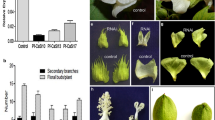Abstract
Afuzzless-lintless (fl) seed mutant ofGossypium hirsutum L. cv. Xu-142 was investigated to study cotton fiber development. Scanning electron microscopy revealed that fiber initials were virtually absent fromfl ovules. RT-PCR analysis showed that the steady-state levels of transcripts of the fiber-specificE6 andExpansin genes were high in wild type (WT) ovules during the fiber initiation and elongation stages, and peaked around 15 days post anthesis (DPA), but only a trace amount of these transcripts was detectable infl ovules of all developmental stages investigated.CotmybA, a member of theMyb family, exhibited a clear expression in developing WT ovules, but the expression was abnormal infl ovules. Application of GA3, or GA3 plus IAA, to the culture medium rescuedin vitro fiber initiation and growth offl ovules only partially. In addition, transcription ofE6 andExpansin genes ofin vitro cultured WT andfl ovules responded similarly to exogenous hormones. The hormones had less effect onCotmybA transcription in ovules culturedin vitro, and again the WT andfl ovules showed a similar expression. These results suggest that the abnormal or extremely low level of expression ofE6, Expansin andCotmybA genes in developingfl seeds is related to the absence of seed-hairs, and the mechanism underlying needs further investigation.
Similar content being viewed by others
References
Basra, A. S., Malik, C. P., Development of cotton fiber, Int. Rev. Cytol., 1984, 89: 65.
Graves, D. A., Stewart, J. M., Chronology of the differentiation of cotton (Gossypium hirsutum L.) fiber cells, Planta, 1988, 175: 254.
Ryser, U., Cell wall biosynthesis in differentiating cotton fibers, Eur. J. Cell Biol., 1985, 39: 236.
Willison, J. H. M., Brown, R. M., An examination of the developing cotton fiber: wall and plasmalemma, Protoplasma, 1977, 92: 21.
Beasly, C. A., Ting, I. P., The effects of plant growth substances onin vitro fiber development from fertilized cotton ovules, Am. J. Bot., 1973, 60: 130.
Momtaz, O. A., Effect of plant growth regulators onin vitro fiber development from unfertilized and fertilized Egyptian cotton ovules, J. Plant Growth Regul., 1998, 25: 159.
John, M. E., Crow, L. J., Gene expression in cotton (Gossypium hirsutum L.) fiber: cloning of the mRNAs, Proc. Natl. Acad. Sci. USA, 1992, 89: 5769.
John, M. E., Keller, G., Characterization of mRNA for a proline-rich protein of cotton fiber, Plant Physiol., 1995, 108: 669.
Orford, S. J., Timmis, J. N., Specific expression of an expansin gene during elongation of cotton fibers, Biochim. Biophy. Acta, 1998, 1398: 342.
Loguerico, L. L., Zhang, J. Q., Wilkins, T. A., Differential regulation of six novel MYB-domain genes defines two distinct expression patterns in allotetraploid cotton (Gossypium hirsutum L.), Mol. Gen. Genet., 1999, 261: 660.
Payne, T., Clement, J., Arnold, D. et al., Heterologous myb genes distinct from GL1 enhance trichome production when overexpressed inNicotiana tabacum, Develop., 1999, 126: 671.
Zhang, T. Z., Pan, J. J., Genetic analysis offuzzless lintless mutant in upland cotton, Jiangsu J. Agr. Sci., 1991, 7: 13.
Ruan, Y. L., Chourey, P. S., A fiberless seed mutation in cotton is associated with lack of fiber cell initiation in ovule epidermis and alterations in sucrose synthase expression and carbon partitioning in developing seeds, Plant Physiol., 1998, 118:399.
Meng, Y. L., Jia, J. W., Liu, C. J. et al., Coordinated accumulation of (+)-δ-cadinene synthase mRNAs and gossypol in developing seedsof Gossypium hirsutum and a new member of the cad1 family fromG. arboreum, J. Nat. Prod., 1999, 62: 248.
Ausubel, F. M., Brent, R., Kingston, R. E. et al., Current Protocols in Molecular Biology, New York: John Wiley, 1995.
Joshi, P. C., Wadhwani, A. M., Johri, B. M., Morphological and embryological studies ofGossypium L., Indian J. Agr. Res., 1967, 33: 1337.
Stewart, J. M., Fiber initiation on the cotton ovule (Gossypium hirsutum), Am. J. Bot., 1975, 62: 723.
John, M. E., Structural characterization of genes corresponding to cotton fiber mRNA, E6: reduced E6 protein in transgenic plants by antisense gene, Plant Mol. Biol., 1996, 30: 297.
Liu, K., Sun, J., Zhang, T. Z. et al., Effects of endogenous and exogenous phytohormone on fiber initiation on ovules fromafuzzless-lintless mutant vs. its isogenic wild-type line in upland cotton, Acta Gossypii Sinica, 1999, 11: 48.
Chen, J. G., Du, X. M., Zhou, X. et al., Levels of cytokinins in the ovules of cotton mutants with altered fiber development, J. Plant Growth Regul., 1997, 16: 181.
Author information
Authors and Affiliations
Corresponding authors
Rights and permissions
About this article
Cite this article
Yu, X., Zhu, Y., Lu, S. et al. A comparative analysis ofafuzzless-lintless mutant ofGossypium hirsutum L. cv. Xu-142. Sci. China Ser. C.-Life Sci. 43, 623–630 (2000). https://doi.org/10.1007/BF02882283
Received:
Issue Date:
DOI: https://doi.org/10.1007/BF02882283




